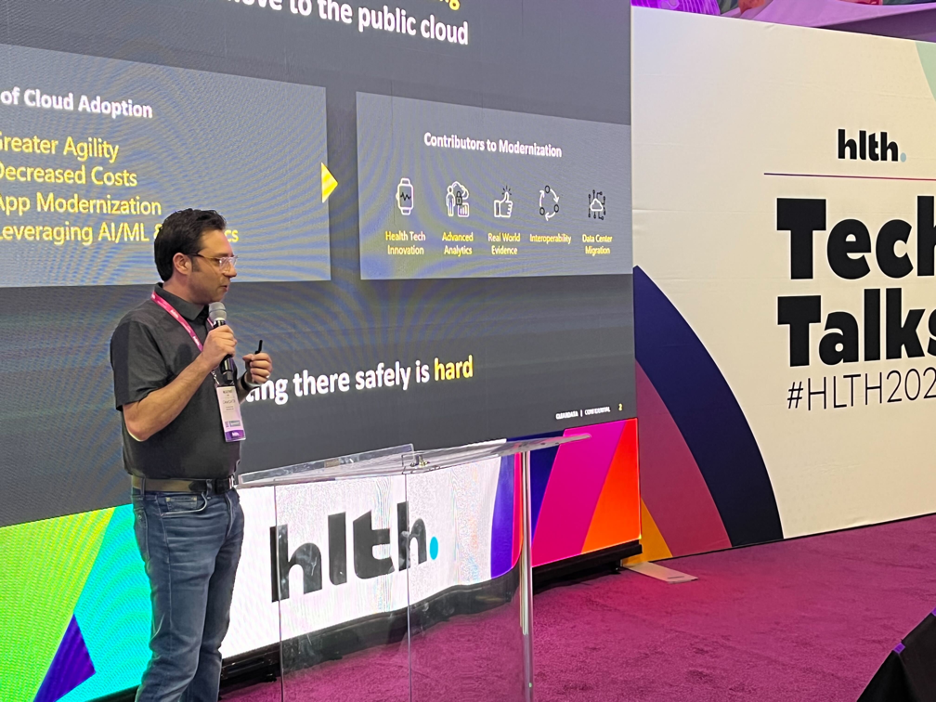At this point, we are all aware the American healthcare environment has undergone a generational shift in the last 3 years since the beginning of the covid-19 pandemic. Although we witness the incredible work that businesses and organizations in the healthcare space do every day – across our hundreds of healthcare clients – HLTH 2022 was a special event for us to sponsor and attend, hearing about the latest innovations and developments in our space. Below are the top 5 takeaways that every operator in the healthcare industry should be aware of in case you weren’t at this year’s HLTH conference.

#1: HLTH Leads Healthcare Conferences
Our consensus from our time on the ground at HLTH 2022 was very promising. What started out as roughly 3,500 attendees in the inaugural 2018 conference has grown over time, nearly tripling, to over 9,500 attendees with hundreds of speakers and sponsors at this year’s gathering.
After speaking with so many of our customers and partners at the ClearDATA booth, it’s clear that healthcare in America is still executing on their critical mission: to improve the way we live, and our quality of health, every day. Even though we may be navigating economic uncertainty and a constantly shifting regulatory environment, every attendee was well aware of what’s at stake when we come to work every day.
With spin-off conferences slated for Europe and HLTH 2023 already on the books, we expect to see continued presence and energy from future conferences. And if you could only pick one healthcare conference to attend all year, HLTH would be a top choice.

#2: Growth In Less-Than-Favorable Market Conditions
As the global economy slows down and faces headwinds, access to capital is becoming increasingly expensive and restrictive. As a result, healthcare business leaders and investors both agreed that healthcare companies are having to return to the fundamentals: growing sustainably and on their own merits, tightly controlling burn rate, and demonstrating value for their customers. Multiple panels at HLTH 2022 poked fun at the fact that the health tech unicorns seem to have quietly faded away, and the sky-high valuations that investors had to compete for have now returned to more normalized figures.
Although many healthcare operators and investors are wary of an American recession, they remain optimistic that funding could return in Q2 of 2023 as the Federal Reserve is expected to pause interest rate hikes and investors become more willing to deploy capital to companies at more favorable valuations. With multiple companies announcing high-profile, recent financings at HLTH 2022, investors are still eagerly looking for opportunities.
#3: Digital Health Innovations Abound
As technology iterates and improves over time, it has been remarkable to observe founders build out visions for healthcare treatment that would have seemed like science fiction a decade ago. While some conference attendees were candid about the fact that digital health hasn’t delivered on every promise made, the announced partnerships and innovations on the horizon seem positive for the American healthcare patient.
Some of the major highlights include: COTA, a data analytics company announced a partnership with Google Cloud to develop algorithms that will help provide clarity around unstructured data from EHRs, NuraLogix Researchers announced the capability to assess type 2 diabetes and blood biomarker health issues using any video-enabled device, and BrainCheck was awarded $1.5m grant from the government agency SBIR, which some have dubbed as “America’s Seed Fund.”
Overall, the sentiment gathered from HLTH 2022 is that valuations may be down for some digital health companies, but innovation and building is on its way up.

Our very own Wayne Saxe, VP of Solutions Architecture, speaking to conference attendees.
#4: Value-Based Care Is A Persistent Problem
Value-based care, or the aligning of incentives for healthcare providers to be compensated commensurately with the level of care that they provide to patients, has been a challenging problem to solve for the industry in recent years. A great idea in theory, with plenty of coverage and discussion in the industry, one recent survey found that value-based payment makes up only 6.7% of primary care revenue.
While it’s encouraging to see that providers are earning some revenue from value-based care, the industry still has a long way to go. Multiple panels from HLTH 2022 focused on how value-based care has received plenty of lip service, and the financials are still needed to support the attention it has received. With multiple friction points – relating to billing and scheduling – value-based care is top of mind for many healthcare players to improve on.
#5: AI Continues To Play a Prominent Role
Artificial Intelligence (AI) and Machine Learning (ML) are fields with immense potential to improve patient outcomes and optimize business performance in healthcare. HLTH highlighted AI/ML innovations on multiple fronts.
Those efforts included improving the quality of patient data that underpin the AI/ML algorithms, which has been criticized for not reflecting a diverse enough patient population. In addition, with so many AI/ML technologies claiming to be the latest and greatest innovation, other organizations are entering the space to create national registries that track and record efficacy, to make it easier for healthcare organizations to validate their effectiveness.
Plus, health tech companies shared different approaches on how they work with providers to pilot machine learning algorithms and market them to new potential customers. Other executives shared their insights on the data used in healthcare – one even went as far as saying that data “is the new oil”, but its maximum value can only be extracted once it’s been refined.
Finally, other AI/ML innovations on the horizon are coming from companies that offer valuable time-savings to physicians during the course of patient treatment. We heard from DeepScribe, who closed a $30 million Series A round earlier this year, about how their automated physician natural language processing software summarizes a physician’s conversation with a patient and auto-populates those notes into the EMR fields.

An Innovation-Filled Industry
One thing is for certain as we reflect on HLTH 2022: the American healthcare industry may be filled with rigor – and occasionally arduous regulations – but it is never boring. Every day, rational and optimistic business leaders and builders in tech are working in the space to help support a healthier population.
As a proud sponsor of HLTH 2022, we’re excited to attend future conferences and be part of such a dynamic ecosystem.


